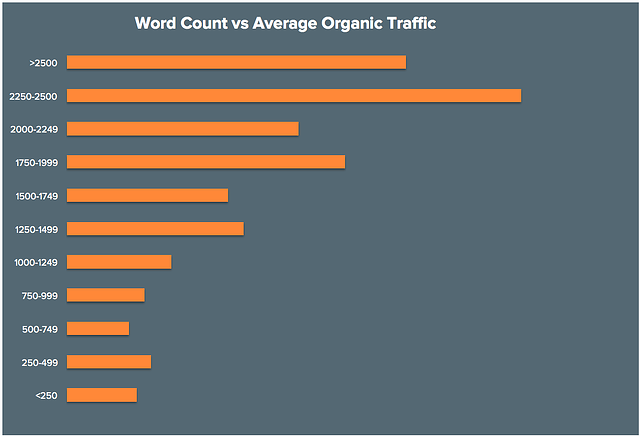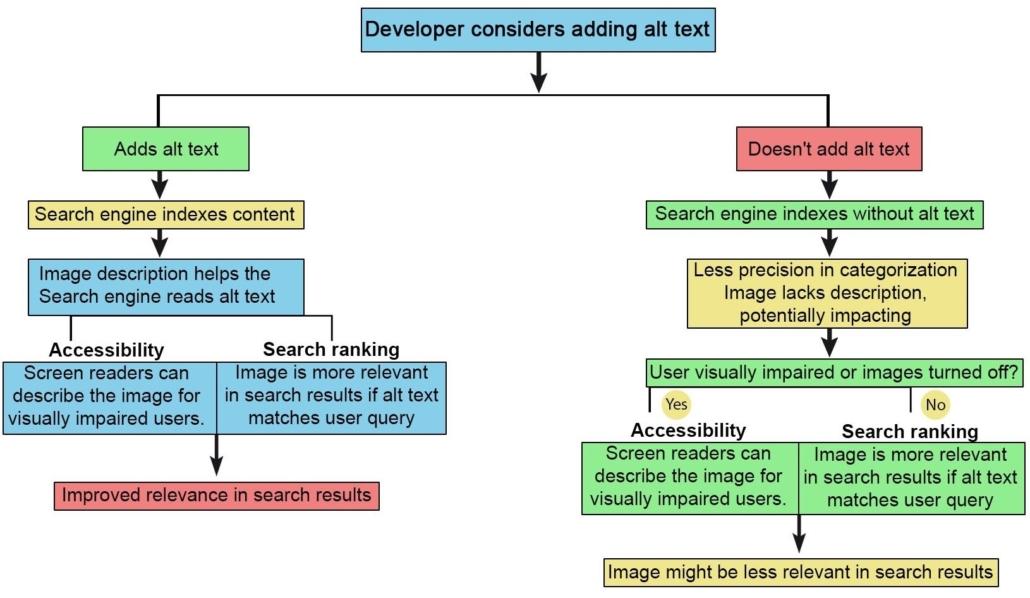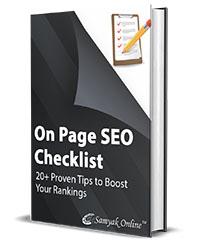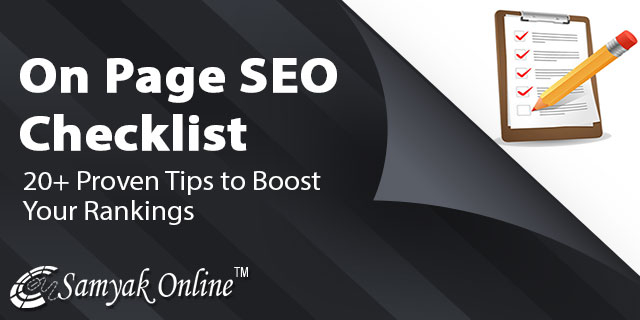On Page SEO Checklist – 20+ Proven Tips to Boost Your Rankings
Last Updated on February 6, 2024 by Subhash Jain
You might be wondering to know the reasons that are harming the results of your search engine optimization campaign. The numbers of websites don’t get expected SEO results despite changing the SEO strategies and practices. If you too are experiencing the same and are not satisfied with the improvement in ranking and traffic by the ongoing SEO campaign, it is time to evaluate the on-page SEO parameters of your website with a professional on-page SEO perspective either yourself or by an On Page SEO agency. To help you optimize on-page SEO parameters, here I list experienced-based and project-tested 20+ on-page SEO tips.
Primary Keyword should be in H1 Title Tag
Title Tag optimization helps search engines to assess the relevance of the content with a search term. Though most SEOs are seen talking about H1s and using H1s but the truth is that very few optimize H1 Title Tag.
So, what is H1 in an HTML tag? H1 in the title tag indicates the heading of the webpage. Then, what is a tag? It is a code snippet that guides the web browser on the way to display that webpage. Out of six HTML headings, H1 is considered the most important to rank a website.
The presence of the primary keyword in the H1 tag improves the chances of increased visibility in search results. The nearer the primary keyword is to the starting of the title tag, the more weight it gains in search engines.
Tip: Mention your brand with the primary keyword/product category and use brackets to increase readability.
Secondary Keywords Should Be in H2 HTML Tag
Now you are familiar with H1, H2, H3, …to H6 in title tags. H2 is the first sub-heading in web page content after the main heading.
H2 tag should include keywords related to primary keywords but with a particular focus on a specific topic. Secondary keywords in the H2 HTML tag tell search engines about the important services/products a website deals in.
H2 headers in HTML tags enriched with secondary keywords support search engines to drill down your website better; it increases the chances for better ranking.
Tip: You can use more than H2 tags also as the Structural element, Accessibility aid, and Navigational tool for enhanced user experience and accessibility by search engines.
Keyword Order Affects Rankings
The ranking of a website fluctuates according to the words used in the search query. For example, a website ranking at #5 for ‘SEO company in India’ doesn’t rank at the same # for ‘India SEO company”.
Google gives value to users’ intent; therefore, the change of words in search queries changes the website ranking search results.
Tip: You can use Google Suggest to explore variations of keywords/phrases in line with a searcher’s intent.
Meta Descriptions
The snippet of about 155 characters, optimal meta description summarizes a page’s content to help search engines assess the provided information in response to a query.
Though a meta description is not a ranking factor, it impacts click-through rate (CTR) and conversions because it appears as a part of the SERP snippet below the web page’s breadcrumb path.
The meta description should be unique, descriptive and keyword-rich for each page.
Tip: Optimize meta description with keywords based on the findings of research on SERPs for Targeted Keywords and competition.
SEO Friendly URLs
The presence of primary keywords in a URL is considered a ranking factor. The search engines like shorter URL structures defining the context of the web page.
The web page URL should be short so that it appears in the search snippet. URL should include primary keywords so that the crawlers can understand the context of page content. Google’s John Mueller says about URL length, “Personally, I try to keep them shorter than 1,000 characters”. URL length plays an important role in canonicalization.
Tip: Foster SEO friendliness of URLs by using a relevant keyword, reader-friendly with the use of hyphens, the standard process for URL naming, etc.
LSI Keywords
Latent Semantic Indexing keywords are semantically-related to a particular topic. With the evolution of Latent Semantic Indexing (LSI), a natural-language processing technique, the importance of LSI keywords has increased manifold from an SEO perspective.
LSI technology uses a mathematical formula to establish a relationship between phrases and words. Search engines using LSI technology go exploring beyond the exact-query matching to deliver much better relevant results.
Tip: You can use Google Autocomplete to organize and optimize the LSI keywords list and usage.
Keyword Density / Keyword Frequency
Though the use of keywords helps search engines and users find your content easily but it doesn’t allow you to stuff keywords; keyword stuffing is known as a black-hat SEO practice that may lead to serious penalization.
While there is no hard & fast rule to limit keyword density but based on experiences, most SEOs recommend 1-2% keyword frequency/density.
Tip: There are a number of free tools to check the keyword frequency/density on a webpage; the one I recommend here is ‘On Page SEO Checker’ tool by Semrush.
Keyword Cannibalization
Keyword cannibalization is the occurrence when multiple pages of a website target similar or identical keywords. As a result, Google can’t decide to order web pages for ranking; ultimately, your website suffers in organic ranking.
This means that sometimes it will give a higher ranking to the web page you don’t mean to prioritize. So, how to find the Keyword Cannibalization?
Tip: Conduct a content audit and explore historic ranking to find the keyword cannibalization. Keyword Cannibalization should always be eliminated to avoid competition between the web page for the same keywords in organic listing.
Content Should Be Above The Fold
The SEO gains highly depend upon how Google and users see the content without scrolling.
Above-the-fold web content impacts the engagement metrics because it inspires users to stay and explore the provided information on other pages also. The websites having above-the-fold compelling content succeed to get lower bounce rates and higher conversion rates.
Tip: Keep the content design simple to use, optimize content for different devices, serve engaging information for high usability, and answer probable queries, etc.
Unique, Engaging, and Valuable Content
Keeping the visitors engaged for a longer period to initiate an act is the key success factor of on-page SEO.
UX plays an important role but the content quality and the way to serve it also matter a lot. Here comes the role of a subject-expert author who knows the demographics of the target audience.
The valuable content is trusted to trigger a measurable response from the target audience because your creatively presented content is in line with their intent. The access to Google Analytics and Google Search Console gives you a real-time picture about- where you can improve content quality.
Tip: Organic traffic, Organic Clicks, Impressions, CTR, and Conversion Rate are the key metrics that you should scale to optimize the web content the best.
Length and Depth of Content
The length and depth of content are two different things. Depth of the content defines the closeness of your quality content with the particular subject while the length of content is the volume of content.
For results-delivering SEO, both the length and depth of the content are important. Using long on-page keywords optimized high-quality valuable content (more than 2000 words) close to the particular subject matter helps to rank a website higher.
Though Google doesn’t fix a page’s rank based on its word count, still, relevant, and optimized content length influences the website’s organic traffic. A graph below from Hubspot correlates content length and backlinks-

Google wants to facilitate users to find all the needed information at least efforts of clicking more pages. Therefore, the long content, comprehensive to address all the concerns of particular users’ segments on a particular topic, is ranked better.
Tip: Follow the content writing formula- ‘Problem-Agitate-Solution’.
Spelling and Grammar
Though ‘Spelling and Grammar’ is not a direct ranking factor but it is a strong trust factor.
The use of proper spelling and grammar is as important as using optimized keywords, headings, and information. Professional use of spelling and grammar is a signal of professionalism and credibility.
User experience centers around readability and comprehension; if there are too many mistakes in spelling and grammar making the content of poor quality, users and search engines will drift from your website.
Tip: Improve readability by addressing users’ intent, use tools to check spelling and grammar, optimize keywords usage, and refrain from sales pitch ….
Use Listicles
The listicles are used to convey the critical information in an effective, impressive, engaging, memorable, and pointed to concerns manner.
What are the listicles?
Listicles are a piece of content presented in a listed format. Listicles are effective to get more free backlinks. Listicles are a great asset from an SEO perspective because they allow you to use more keywords and phrases in the limited-volume content.
When you use keywords in the subheading of listicles, search engines easily assess your content context and your website ranking gets a boost.
Tips: Write for your audience, formulate a strategy to mention the particular products/services at a priority, be the voice of your brand, and offer values for readers.
Use of Tabular Data
Use of tabular data is a great practice to make web content more trustworthy, authoritative, and easy to consume.
Google filters table data by using additional algorithms powered by machine learning techniques to determine the relevance and quality based on search queries. The addition of tables improves and establishes the relevancy & accuracy of the certified facts; it increases the chances of your website appearing in the form of structured snippets creating more traffic to improve ranking.
Tip: Google Tables allows users to explore public Fusion Tables and millions of web pages constructed with tabulated data.
Improve Content Readability
The readability of web content is a great contributor to the success of any SEO campaign.
So, what is readability?
It is the ease of reading and understanding the content. Readability is calculated by a formula using many metrics like sentence length, average syllables/word, frequency of words, and others.
The readability score ranges from 0 to 100. A higher score means, your content is good to read and understand. The benefits of high readability are improved engagement, success in conveying brand messages, and more leads.
Some readability tools I would recommend are- Yoast WordPress plugin, SearchMetrics
Content Experience, and Text Optimizer. The popular algorithms for content readability score test are Flesch-Kincaid readability score, Gunning-Fog, SMOG index, and Coleman-Liau. Flesch-Kincaid readability score formula is-
Content Clusters
Content clusters are being used widely by SEOs to establish the authority of their site over a range of topics.
Content clusters use a particular topic modeling and internal linking that improves user experience and boosts the website’s search performance. Under the content clusters strategy, you create a cluster of content related to one topic.
The objective of using content clusters is to model the entire content cluster to be topically relevant as much as is possible. In content clusters creation, you use Informational keywords, Transaction keywords, and Navigational under TOFU – MOFU – BOFU strategy.
Tip: Pick the latest topic, select keywords wisely, set the volume of the content cluster for each set of keywords, and decide the length of each content piece…
Internal Linking
A well-balanced internal links structure helps Google to find, index and understand all the web pages of the website. Internal links facilitate users to navigate easily, help to establish an information hierarchy, and help to spread link equity.
Internal links are hyperlinks that take users from one page to different pages of the same domain. The value of pages, relevance of pages, and relationship between pages are the core values of healthy internal linking.
Tips: Format ideal site structure, highlight the most important content, link relevant hierarchical pages, add contextual links, and add navigational links….
Outbound Linking
Outbound links direct visitors from your web pages to other websites. Outbound links have always been an integral part of any SEO strategy. Outbound links are seen as an endorsement of being authoritative, trustworthy, and reputable.
Mueller said- ““…valuable outbound authority links are part of what Google likes to see as part of its recent Google Panda update….. By adhering to some of the following best practices when optimizing outbound links – you could be seeing an effect on your visibility and ranking.”
Tips: Link your web pages with pages that are relevant, valuable for users, have good page or domain authority, and have high numbers of social media shares.
Add FAQ for Voice Search
Google loves precise answers to voice queries; here comes the increasing importance of FAQs that you should essentially have on your website.
A professionally created FAQ page helps your website prove relevant and improves SERPs ranking. FAQ section facilitates you to provide contextual information around the target keywords that you could serve on web pages.
Tips: Be conversational, use schema on your FAQ page, use location-specific long-tail keywords, target mobile search intent, and create persona-based content…..
Update Outdated Content to Keep it Fresh
Updating web content regularly fosters the trust of website users. The customers who rely on your website want you to see first in serving the latest information.
Updated information strengthens domain authority also. The more times you update web content, the more times Google crawls your website and considers it more relevant to rank it higher.
Tips: Make sure that the updated content appears fast on all the devices, ensure that robust security measures are applied, and focus on providing information rather than selling.
Optimizing Images
Optimizing images for the web is crucial for improving page load times, which is a key factor for both SEO and user experience. The process includes several steps:
- Selecting the Right File Format: JPEGs are great for photographs due to their high compression levels, while PNGs are better for images that require transparency.
- Resizing Images: Images should be resized to fit the display size on various devices, ensuring they are not unnecessarily large.
- Compressing Files: Use tools to compress images, reducing file size without compromising quality.
Alt Text for All Images
Describe images for SEO and screen readers. Like use descriptive alt text for all images, detailing what each image represents.
It describes the image content and context, helping search engines understand the image and assisting visually impaired users.
Here is a diagram illustrating this process:
An image is uploaded to a webpage, which is integral to the website’s content.
- A web developer adds alt text to an image, with the alt text being “On-Page SEO Services”.
- A search engine crawls the web page and indexes its content, including images.
- During indexing, the search engine reads the alt text to understand what the image is about, aiding in accurate categorization.
- Appropriate and descriptive alt text improves the image’s relevance in search results, enhancing the webpage’s SEO.
- For users who are visually impaired or in scenarios where the image cannot be displayed, screen readers read out the alt text, making the content accessible.
- A user enters a search query related to the content of the image, such as “On-Page SEO Services”.
- If the alt text and content relevance match the user’s query, the image (along with its webpage) appears in the search results.
- Visually impaired users or those with images turned off can understand the image content through the alt text read by screen readers.

Utilizing Canonical Tags
My website has two pages with similar content: one is a detailed article about SEO strategies (Page A), and the other is a summary of the same topic (Page B). I want search engines to focus on Page A as it’s more comprehensive. By adding a canonical tag to the header of Page B pointing to Page A, I inform search engines that Page A is the primary source. This prevents any SEO confusion or dilution due to having similar content on multiple pages.
Adding a canonical tag to your web page is a straightforward process. Here’s how you can do it, using the example of your SEO services website with two similar pages:
- Identify the Canonical Page: First, decide which page (Page A or Page B) you want search engines to consider as the primary one. In your example, Page A is the detailed article about SEO strategies, and you’ve decided it should be the canonical page.
- Edit the HTML of the Non-Canonical Page: Access the HTML code of Page B, which is the page you’ve decided is less important or the duplicate page.
- Add the Canonical Tag: In the <head> section of the HTML of Page B, you need to insert a canonical link element. This tag will point to the URL of Page A. The tag should look something like this:
- <html>
- <link rel=”canonical” href=”http://www.Samyakonline.net/page-a” />
- In this tag, replace http://www.Samyakonline.net/page-a with the actual URL of Page A.
- Save and Upload the Changes: After adding the tag, save your changes and upload the updated file to your server. If your website uses a content management system (CMS) like WordPress, you may be able to add the canonical tag through the CMS interface instead of editing the HTML directly.
- Verify the Implementation: Finally, it’s good practice to check if the canonical tag is implemented correctly. You can do this by viewing the page source of Page B and confirming that the canonical tag points to the URL of Page A.
By implementing the canonical tag in this manner, you’re effectively communicating to search engines which page should be considered the primary source of content. This helps in avoiding issues with duplicate content and ensures that the SEO value is attributed correctly to your chosen page.
Integrating Social Sharing Buttons
Suppose you’ve written a compelling article on the latest digital marketing trends on your website. By adding social sharing buttons like “Share on Facebook” or “Tweet this,” you make it easier for your readers to share this article on their social networks. This not only increases the visibility of your content but also potentially drives more traffic to your website, expanding your reach and engagement.
Monitoring User Engagement Metrics
Let’s say your analytics show that visitors are quickly leaving your service page about ‘Content Marketing Strategies.’ This high bounce rate might indicate that the page isn’t engaging or doesn’t meet user expectations. By analyzing these metrics, you can understand user behavior better and make necessary adjustments, like improving content or design, to keep visitors engaged and improve your website’s overall SEO performance.
Ensuring Website Accessibility
Consider a visually impaired user visiting your digital marketing services website. If your site is designed with accessibility in mind, such as using clear fonts, alt text for images, and keyboard navigability, this user can easily access and understand your content. Making your site accessible not only broadens your audience but also complies with SEO best practices, as search engines favor websites that cater to a diverse range of users.
Configuring Robots.txt File
Imagine your website has certain pages that you don’t want search engines to index, like a duplicate page of a blog post or an internal login page. By configuring the robots.txt file, you can guide search engine crawlers to ignore these pages. This ensures that only the content you want is indexed and visible in search results, maintaining the quality of your site’s SEO.
Breadcrumb Navigation
Breadcrumb navigation is particularly useful for websites with multiple layers of content, like a digital marketing website offering various services. It provides a trail for the user to follow back to the starting or entry point. It also helps search engines understand the structure of your website. For instance, breadcrumbs might look like this: Home > Services > SEO Optimization. This clarifies the site’s layout to both users and search engines.
FAQs
It depends upon your SEO plans and the nature of your business because updating web page content doesn’t replace the requirement to create new content. Fresh content means unique content that is new to the existing website. If you experience a drop in your website’s organic performance metrics, it is time to update your website content. According to common SEO’s opinion, product descriptions should be updated at least every three months. Web content should be updated every year. If you have a blog section on your website, it needs at least 2 fresh blogs a week. The frequency of social media postings depends upon your social media strategy.
Technical SEO is a part of on-page SEO. It is more focused on functional elements other than content. Technical SEO optimizes all the technical parts of a website that impacts the way your website is presented to search engines and visitors. The on-page SEO optimizes all the elements that are critical to usability and ultimate UX.
In addition to improved ranking, on-page SEO delivers many other benefits also including increased traffic, leads, conversion rate, brand awareness, community reach, etc.
E E-A-T (Expertise, Authoritativeness, and Trustworthiness) concept in on-page SEO came to prominence after Google’s Search Quality Rater guidelines and Medic Update in August 2018. E-A-T is an important factor that Google considers to evaluate web page quality. Expertise, authoritativeness, and trustworthiness of content developers are the core pillars of E-A-T.
Increasing the reach of a business to a wider segment of different communities is a consistent strategy of most marketing plans. Visual search optimization supports businesses to tap the potential clients who initiate searches through Google Images search. The result is more leads and increased brand visibility with improved chances of getting a better rank.
Google’s latest Product Reviews update was released on July 27, 0222. The primary objective to release this update is to promote product review content. Google rewards websites having better insightful review content by ranking higher. The new Product Reviews update is just a refresh of the algorithm with slight adjustments. The Product Reviews update rollout was completed on August 2, 2022.
Rolling out algorithm updates one after the other has become a routine process at Google because the leading search engine wants to ensure that the users get better results and experience with the least effort. To keep yourself updated with Google algorithm changes, you can use Google alerts and 3rd party sources. Sudden ranking fluctuations and traffic changes signal a new algorithm change- minor or major.
Concluding Note
I hope this compilation of 20+ on-page SEO tips will help you instantly boost your organic traffic. I promise to keep expanding this list like in my other blog post. Please keep following this blog to know the latest and to incorporate the latest on-page SEO findings first to stay ahead in organic ranking.
About Author:
Subhash Jain is the Founder of Samyak Online – the top SEO agency in India. Are you looking for SEO services to increase your website traffic, leads and brand recognition? Contact us for Free SEO Proposal.



Leave a Reply
Want to join the discussion?Feel free to contribute!